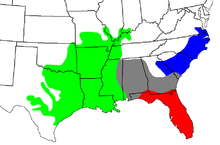Agkistrodon piscivorus piscivorus
| Agkistrodon piscivorus piscivorus | |
|---|---|
| | |
| Scientific classification | |
| Kingdom: | Animalia |
| Phylum: | Chordata |
| Subphylum: | Vertebrata |
| Class: | Reptilia |
| Order: | Squamata |
| Suborder: | Serpentes |
| Family: | Viperidae |
| Subfamily: | Crotalinae |
| Genus: | Agkistrodon |
| Species: | A. piscivorus |
| Subspecies: | A. p. piscivorus |
| Trinomial name | |
| Agkistrodon piscivorus piscivorus (Lacépède, 1789) | |
 | |
| Distribution of subspecies of Agkistrodon piscivorus [1]
A. p. piscivorus Intergradation | |
| Synonyms | |
Agkistrodon piscivorus piscivorus is a venomous pitviper, one of three subspecies of Agkistrodon piscivorus, with different geographic distributions,[6] found in the south eastern United States.
Description
This subspecies reaches 20-48 inches (51-121 cm) in length on average but has reached 74.5 inches (189 cm). The colour is mainly dark, and the body heavy. However younger specimens have red to brown crossbands, with a lighter brown background. The crossbands are spotted and speckled, and the tail suphur coloured. The patterning darkens with time with many older adults being completely black, as shown in the upper illustration.
The scales are keeled and dark broad stripes on the face disguise the eyes, which cannot be seen when viewed from above, and have a vertical (cat's-eye) slit like pupil. The eye is separated from the nostril by a deep facial pit.(These specimens were all photographed in the Francis Beidler Forest)[3]
Geographic range
The United States in southeastern Virginia, the Atlantic Coastal Plain and lower Piedmont of North and South Carolina, including the banks, peninsulas and islands along the Atlantic coast, and west across Georgia (see map).
See also
- List of crotaline species and subspecies
- Crotalinae by common name
- Crotalinae by taxonomic synonyms
- Snakebite
References
- ↑ Campbell JA, Lamar WW. 2004. The Venomous Reptiles of the Western Hemisphere. Comstock Publishing Associates, Ithaca and London. 870 pp. 1500 plates. ISBN 0-8014-4141-2.
- ↑ McDiarmid RW, Campbell JA, Touré T. 1999. Snake Species of the World: A Taxonomic and Geographic Reference, vol. 1. Herpetologists' League. 511 pp. ISBN 1-893777-00-6 (series). ISBN 1-893777-01-4 (volume).
- 1 2 Florida Museum of Natural History: Eastern Cottonmouth
- ↑ Conant R. 1975. A Field Guide to Reptiles and Amphibians of Eastern and Central North America. Second Edition. First published in 1958. Houghton Mifflin Company Boston. 429 pp. 48 plates. ISBN 0-395-19979-4 (hc), ISBN 0-395-19977-8 (pb).
- ↑ Wright AH, Wright AA. 1957. Handbook of Snakes. Comstock Publishing Associates. (7th printing, 1985). 1105 pp. ISBN 0-8014-0463-0.
- ↑ "Agkistrodon piscivorus piscivorus". Integrated Taxonomic Information System. Retrieved 15 May 2014.
Sources
| Wikimedia Commons has media related to Agkistrodon piscivorus. |